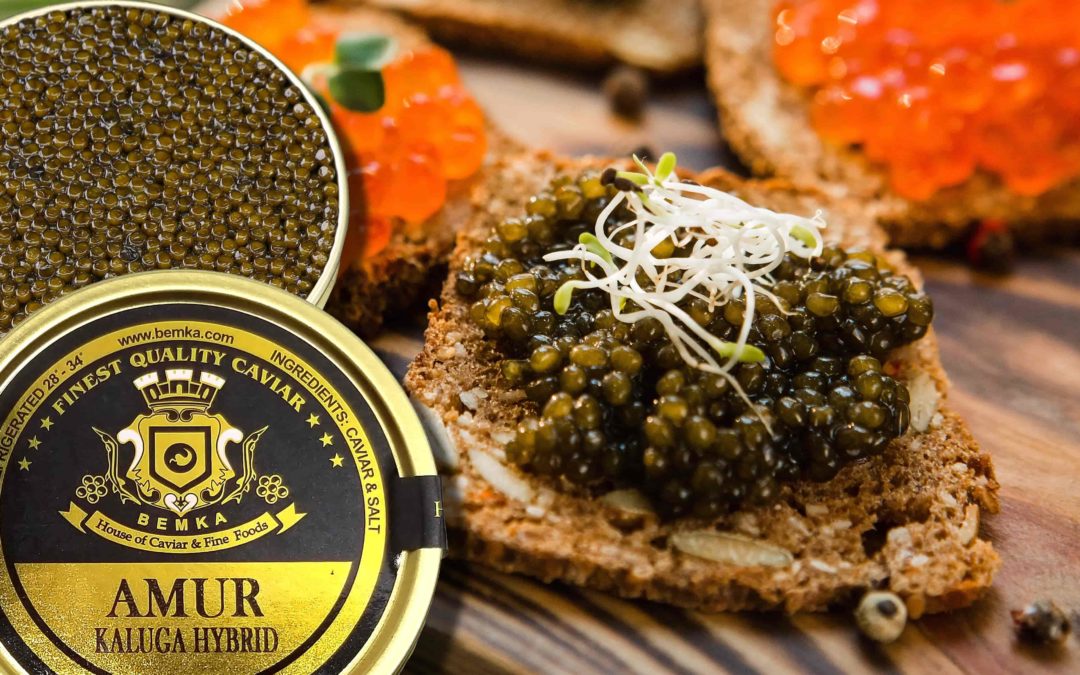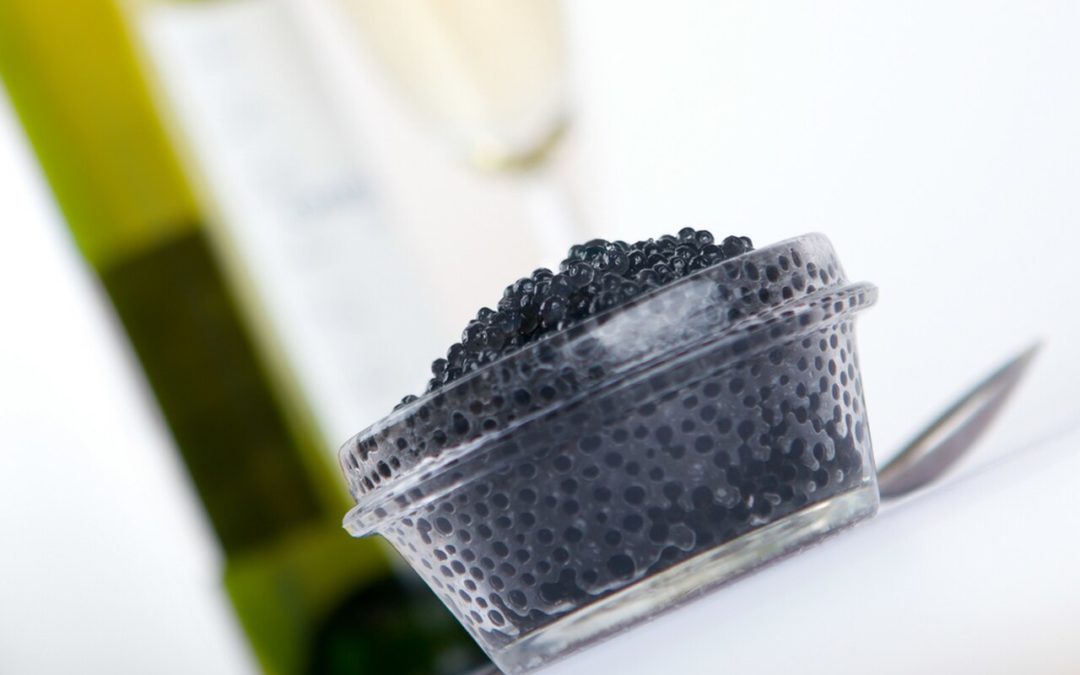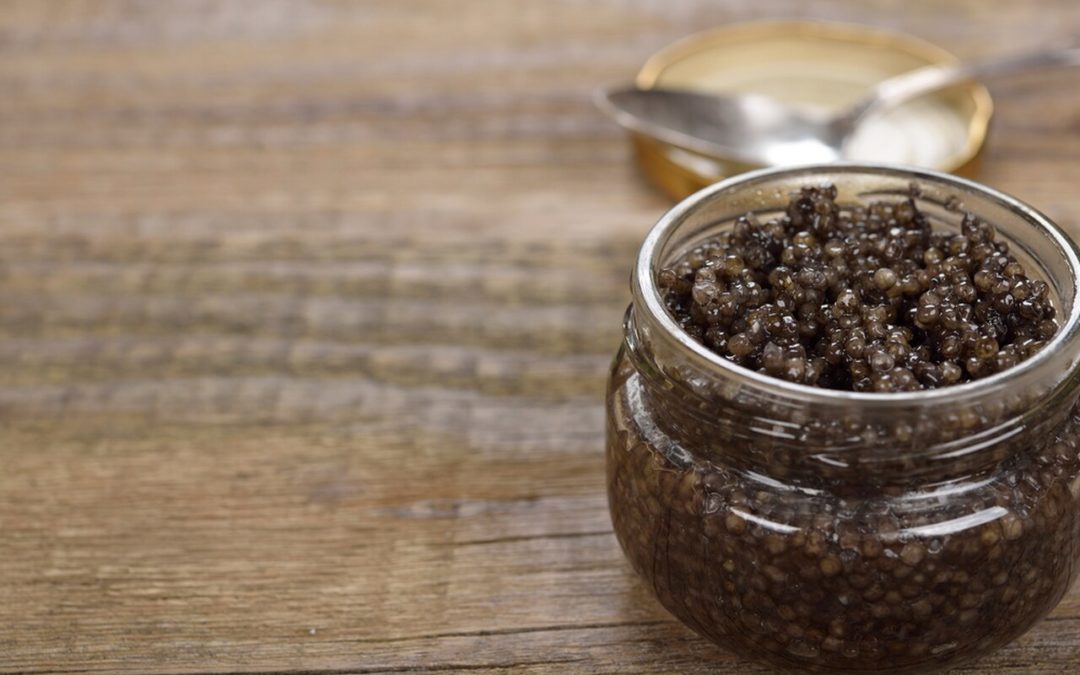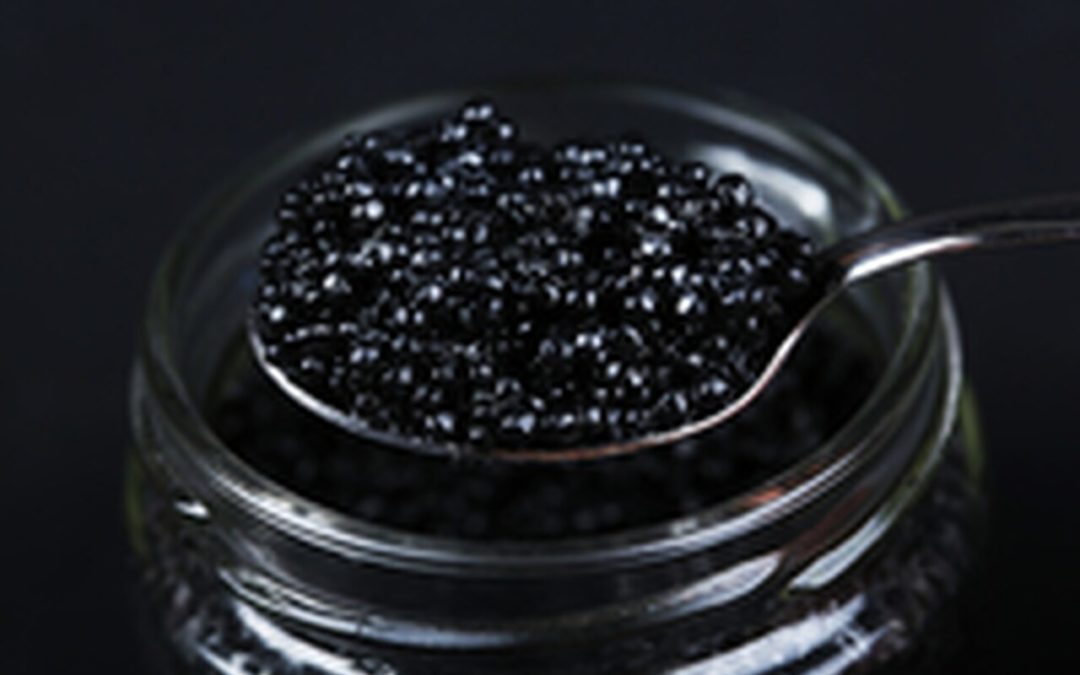
by HOCAFF Team | Sep 21, 2020 | General
You are a foodie that’s splashed out on an exceptionally luxurious treat you have already tasted, and you felt its unique and incomparable flavor. Now, you want to know much more about this delicacy. You have come to this blog to find out what caviar is accompanied by to make an exquisite dish and garnish it. Are you ready to find out? What are you waiting to read more in this new blog post?
Caviar is something that should be savored and made the most of. There are tins sold at all price points, containing different varieties, grades, and caviar sizes. Still, with such a revered product, it’s essential to know how to serve it and what to do with it, so you can enjoy it at its best. And while it may sound counter-intuitive, sometimes serving other foods alongside the delicate eggs can help bring out their favorite flavor.
That is why today, we will talk about how to accompany caviar and how to serve it. Welcome to the world of caviar
What do you eat with caviar?
As a very general rule of thumb, you should serve fewer side dishes as your caviar’s quality increases. The finest, most expensive caviar should only be eaten on its own. Still, if you are serving more affordable eggs at an event, other side dishes can enhance its flavor.

Traditionally, caviar is served on top of blinis, which are mini Russian pancakes made from buckwheat.The blinis act as an edible dish that has a discreet flavor. In this way, they are perfect for serving caviar as a canapé.
Another way is to serve it with crackers or crusty pieces of bread that add a nice crunch and allow the caviar flavor to pop.
They can also be served with lightly buttered bread or simple boiled potatoes; this increases the caviar’s flavor.
Other flavors that go well with caviar include chicken or quail eggs, raw onion, and creme fraiche. You can make the eggs and finely chop the onion, then use it to coat the blinis with caviar and a small dollop of creme fraiche.

For its part, lemon does not work with caviar; the lemon juice is too overwhelming and clashes with caviar’s mineral flavor. It is also not fair to add salt or any other seasoning to caviar; it has a natural salty taste.
The smooth, creamy flavors work very well with caviar, which is why egg, creme fraiche, and blinis make a great side dish.
Besides, caviar is perfect for covering hot dishes such as pasta (a ravioli is a good option), risotto soups, and even sauces. Caviar cannot be cooked as its texture and flavor are destroyed. However, it can be served on an already cooked dish. Cheaper caviar-like colorful salmon roe and tobiko roe allow you to get creative without spending a fortune and are especially suitable for homemade sushi or as a side dish.

It is important to note that many chefs make lovely dishes with caviar. For example, Simon Hulstone serves him with a roll of scallops and prawns with a cauliflower puree. At the same time, Marcus Wareing prepares a luxurious starter of Burrata salad, peas, grapefruit, caviar, and leeks. Many Chef Hideki Hiwatashi’s recipes use caviar as a garnish on raw fish dishes. At the same time, Kevin Mangeolles combines caviar with vegetables and dairy like organic carrots cooked in goat serum.
How to serve Caviar?

The most important rule is never to put metal utensils near the eggs; the metallic taste seriously affects the pure and salty taste of caviar. It will destroy the palate’s subtleties, which is why the metal cans that caviar comes in are lined with plastic to take care of their taste. It is better to use a special caviar spoon, made of bone, plastic, or Mother of pearl.
Caviar should also be served cold, so it is best to keep it refrigerated and decant it into a cold container, preferably filled over ice. You will feel its refreshing flavors, which almost clean the palate, and will make you enjoy your precious delicacy in the best way.

Do not spread or crush the caviar; you will break the eggs’ delicate skin and destroy the texture. One of the highlights of tasting caviar is letting each egg roll onto your palate. And then pop when you bite into it, so use the spoon carefully when serving caviar.
True caviar gourmets believe that the best way to eat and serve fish eggs is without additives, just caviar, and that’s it. They think that only then nothing can prevent you from feeling this highly appreciated flavor.
Now, having all the necessary information to serve this delicacy, you can buy a delicious jar of caviar at the House of Caviar. Do not forget to present the caviar properly to your guests and enjoy a delicious meal.

by HOCAFF Team | Sep 8, 2016 | General
If you are looking for a truly decadent meal on a warm summer evening, pair the best wine with caviar or a great bottle of champagne. Whether you are at home or in a fine restaurant, the perfect wine pairing with caviar or champagne could plummet you into exquisite sensory overload. Remember in order to achieve the most delectable caviar pairings these gourmet indulgences must complement rather than contrast.
While it is true that ideal caviar pairings can be uniquely personal, an unqualified union may interrupt an otherwise delightful epicurean experience. For this reason, we at House of Caviar and Fine Foods have pooled, what some ardent gourmet enthusiasts describe as the best caviar, wine and champagne pairings.
Best Wine with Caviar
- Sauvignon Blanc is a crisp white wine that complements the nutty flavor of the California Royal White Sturgeon Caviar. Based on the ripeness of the grapes used during vinification, this wine may have either a mild herbaceous or zesty lemon flavor that imperceptibly offset the salinity of the Royal White Sturgeon. This wine and caviar pairing enhances the provocative taste of the large firm roe of the white sturgeon which compares to the priciest Osetra.
- Blanc de Noir is a sparkling white wine that enjoys a reputation as one of the best wine with caviar pairings. It teams up particularly well with our Russian Osetra, the classic Siberian Osetra and Imperial Osetra selections. Made from deep red or black grapes, the aromas and long, complex finish of a Blanc de Noir is the perfect accompaniment to a more flavor dense caviar. The buttery taste of the Osetra roe is considered among the most appetizing by avid caviar consumers.
- Pinot Grigio is an Italian wine that is distinctly light-bodied and vibrant. It is a perfect duo with the large lustrous pearls of the Classic White Sturgeon, Hackleback and even Wild Paddlefish caviar. And, while the Pino Gris is of the same variety and the Pinot Noir is a variant-clone of the Pinot Grigio they are less desirable wines to pair with caviar. Their more viscous texture and robust body tend to smother the subtle flavor of this delicacy. Even so, since caviar is often combined with other complex ingredients such as raw onions, eggs, oysters and salmon, it does on occasion, enables these more full-bodies wines to be invited to the caviar party.
Champagne and Caviar
Absolutely nothing pairs better with caviar than champagne. A bite of caviar followed by a sip of the driest champagne and a few seconds of intermingling often result in an unmatched flavor burst. The best way to enjoy caviar is in its purest form with one of the following champagnes.
- Dom Perignon is the ultimate splurge and most frequently selected for champagne and caviar pairings. A flute of this crisp clean champagne presented with a dollop of Kaluga Caviar or other high quality caviar preserves the texture and heightens the taste experience of those exquisite gems.
- Krug Champagne is another favorite among caviar connoisseurs. The understated bouquet of vintage Krug transforms the Juicy brown pearls of any Ossetra Caviar into creamy magic on the tongue.
- Taittinger can accompany both domestic and imported caviar from every price range. This makes it a great caviar pairing champagne. The explosion of bubbles and pop of the decadent eggs creates harmony delicious between the subtleties of the caviar and the delicate buoyancy of this champagne.
In addition to the palate pleasing experience, caviar is a highly nutritious food. As such, splurging on caviar wine and champagne should be a regular enjoyment of life rather than relegated only to special occasions.
Follow House of Caviar and Fine foods online or on Facebook to explore the many ways you can enjoy or incorporate caviar into your lifestyle. You can also purchase the freshest caviar and other specialty foods such as black, white and summer truffles, foie gras and caviar accessories and much more from our online store.

by HOCAFF Team | Sep 8, 2016 | General
The history of caviar tend to lead us to exotic places like the Caspian or Black sea. However, American waters had been teaming with this untapped treasure long before the abundance of sturgeons caught the eye of Henry Schact. Schact is a German immigrant whose name is inextricably linked to caviar because of his pioneering work in establishing the American caviar industry.
Caviar is a captivating subject because of the complexities and simplicities of its past present and future. Unlike the caviar of Europe, the American beginnings of this fragile fare evolved in a round-about sort of fashion. For instance, American Caviar was not always considered the best caviar or a rarefied treat that belonged only on the tables of the wealthy. In fact, the American Caviar story began rather unromantically as part of the diet for Native Americans in the Northeast. That is until Schact found a more lucrative use for the giant sturgeons teaming in the rivers of his new country.
Once Schact recognized the potential at his disposal, the American history of caviar had begun. The industrious and enterprising skills of this man lent themselves well to the rapid development and growth of the caviar industry. Despite the fact that it may not have been considered to be the best caviar, due to the preservation and shipping methods available at the time, before long the United States was producing 90% of the world’s caviar. Schact exported caviar in barrels all over Europe for a dollar a pound. At one point in the American history of caviar, the surplus of this delicacy became part of the nation’s drinking salon marketing strategy. Huge bowls of heavily salted sturgeon roe was placed on bar counters; free for the taking. The saltiness of the caviar made drinkers thirsty which in turn increased liquor revenue.
Overfishing eventually caused the American caviar industry to suffer the same fate as its European counterpart. With the sturgeon population dwindling rapidly, the value of the ethereal pearls increased. As the supply and demand ratio changed, various environmental programs were initiated to sustain the sturgeon population while improving harvesting and preservation methods. And so, fish farms began to pop up near sturgeon habitats.
By 1906 another innovator, Harry Dalbow, introduced the idea of canning caviar. Canning allowed for progress in preservation techniques and longer shelf life. Incidentally, the idea of putting the best caviar in small glass jars was also birthed in the American Caviar industry. Before long, caviar began to claim its status as a luxury food in the United States. Not surprisingly, the pricier caviar became the smaller the portions. This was due to the fact that opening a can of caviar further decreased the shelf life of this delicacy. Eventually, American caviar that was once pushed on drinkers, sold by the barrel or for pennies in American restaurants was now being treated as priceless gems.
Today, the history of caviar from its American beginnings have come full circle. The quality of caviar in the United States rivals that of the best caviar from the Caspian Sea and Black Sea.
Buy Caviar online and follow House of Caviar and Fine foods on our Facebook page to explore the many ways you can enjoy or incorporate caviar into your lifestyle. You can also purchase the freshest domestic or imported caviar and other specialty foods such as black, white and summer truffles, foie gras and accessories from our caviar online store.

by HOCAFF Team | Jul 15, 2016 | General
Learn the Origins of Your Favorite Delicacy: The History of Caviar
Long before Caviar became affiliated with royalty, it was part of the diet in areas where Sturgeon fish was in great abundance. Although accounts of the history of Caviar does not pin a specific date on when the epicurean value of this decadent cuisine began, some records date as far back as pre-historic times.
In essence, caviar is a decadent preparation of the unfertilized eggs or roe of a sturgeon fish. Based on some accounts, caviar is actually the variant of the Persian word “khaya-dar” which means having eggs or egg bearing fish. The Persians who collected the fish eggs for their perceived medicinal value may also have been the first to prepare and appreciate their unique piquancy. However, the tradition of salting roe originated with the Chinese who used this method to preserve Carp eggs.
Ancient classical literature contains several references about caviar. Aristotle who lived during the 4 th Century B.C. spoke so highly of the Sturgeon fish eggs that it became a consummate offering at banquets. Since Sturgeons were found mainly in the Caspian Sea and Black Sea, it was the Russian Tsars that launched its popularity as an opulent epicurean delight. Its status was also significantly heightened towards the end of the 1800s, when the French started importing caviar from Russia, such as Beluga Caviar. In order to preserve the roe for transporting purposes however, the delicate eggs were heavily salted and packed into wooden crates. Despite the fact that these crude processing methods belied the quality of the end product, through consistent demand, Caviar, managed to continue its evolution as a highly sought after and pricey fare. At one point in Britain’s history, Sturgeons were reserved exclusively for the kings and elite of that society and was even knighted as the “Royal Fish”.
Still, at one point in American history, a serving of caviar was sold for a nickel in fine restaurants. Even more unbelievable, this salty delicacy was at times given to saloon patrons to encourage spending on liquor. The proliferation of Sturgeon in the Delaware River eventually spurred the development of a caviar business in 1873 by a German immigrant by the name of Henry Schacht. Soon Schacht began exporting Caviar throughout the world, including to Russia, for a mere dollar a pound. By the end of the 19th century, the United States was producing approximately 90% of the world’s caviar.
Today, this ultimate luxury food is available in a range of prices and varieties. Although the best caviar is a matter of preference, experts say quality is determined by handling and a number of other variables such as maturity of the eggs, texture, color and depth of flavor.
Topping the list of most expensive and well known (yet restricted to sell in the US) is the Beluga Caviar. Although not all Caviar lovers will agree that this is the best of the best, it definitely commands the highest price. Beluga Caviar along with Sevruga and Ossetra are considered to be the most sought after and expensive Caviar. However, overfishing has depleted and endangered the Caspian Sea Sturgeon population, which has made Beluga Caviar illegal to import to the USA. As the Beluga becomes less available, it has created a growing demand for Golden Imperial Ossetra or Kaluga Caviar . Experts say the Kaluga roe is an exquisite substitute that is similar in appearance and flavor to Beluga Caviar. The selection of Kaluga Caviar comes from the Huso Daricus Sturgeon and Amur Sturgeon eggs. Most importantly for many of today’s consumer, it is a sustainable product.
The fall off of supply of Caviar from the Caspian and Black Sea has also expanded interest and the market for other types of fish roe including Hackleback, Royal White Sturgeon , Paddlefish, Bowfin, trout and salmon, amongst others. For instance, the sweet buttery and nutty flavor of the Hackleback Caviar is similar to Caspian Ossetra. As such, as caviar lovers expanded their palate, many consider domestic caviars to be an appealing and affordable alternative to their international counterparts.









